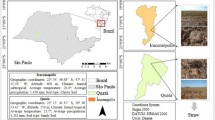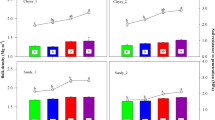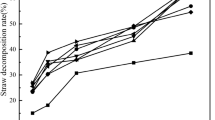Abstract
The objectives of this study are to assess the effects of sugarcane straw removal with fertilizer application on (i) N source (soil mineral N, SOM lability (microbial biomass C and N)) and N source efficiency and (ii) the sugarcane straw decomposition. The field experiment used a randomized complete block design (RCBD) with three replications based on micro-plot size 1 m2 and litter bag study (32 weeks) at Khon Kaen University in a Yasothon sandy soil. A sugarcane straw dry weight (DW) of 6.25 tons ha−1 was used. There are eight treatments, i.e., burn (sugarcane straw burned after application), 50% (sugarcane straw at 312 g m−2 application), 75% (sugarcane straw at 468 g m−2 application), 100% (sugarcane straw at 625 g m−2 application), 50% + F (50% + recommended fertilizer application (4.7-g N m−2, 2.1-g P m−2 and 3.9-g K m−2)), 75% + F, 100% + F and 100% + U (100% + dissolved urea at the rate of 1.44-g N m−2). The litter bag and soil were sampled at 1, 2, 4, 8, 16, 24 and 32 weeks after sugarcane straw application. Our study revealed that sugarcane straw at a rate of 50% (312 g m−2) provided greatest N source efficiency, while such a removal rate together with chemical fertilizer (recommended rate) application not only enhanced mineral N, microbial biomass C and microbial biomass N but also accelerated sugarcane straw decomposition and led to nutrient (N, P and K) release. Thus, this practice can be a promising sugarcane straw removal approach for sustainable sugarcane production systems.





Similar content being viewed by others
References
Amato, M., and J.N. Ladd. 1988. Assay for microbial biomass based on ninhydrin reactive nitrogen in extracts of fumigated soil. Soil Biology and Biochemistry 20: 107–114.
Andini, A., S. Bonnet, P. Rousset, and U. Hasanudin. 2018. Impact of open burning of crop residues on air pollution and climate change in Indonesia. Current Science 115: 2259–2266.
Bray, R.A., and L.T. Kurtz. 1954. Determination of total organic and available form of phosphorus in soil. Soil Science 59: 39–45.
Butphu, S., and W. Kaewpradit. 2022. Impacts of eucalyptus biochar application on greenhouse gas emission from an upland rice–sugarcane cropping system on sandy soil. Experimental Agriculture 58.
Butphu, S., F. Rasche, G. Cadisch, and W. Kaewpradit. 2020. Eucalyptus biochar application enhances Ca uptake of upland rice, soil available P, exchangeable K, yield, and N use efficiency of sugarcane in a crop rotation system. Journal of Plant Nutrition and Soil Science 183: 58–68.
Cantarella, H., C.E.P. Cerri, J.L.N. Carvalho, and P.S.G. Magalhães. 2013. How much sugarcane trash should be left on the soil? Scientia Agricola 70: 1–1.
Carmo, J.B.D., S. Filoso, L.C. Zotelli, E.R. de Sousa Neto, L.M. Pitombo, P.J. Duarte-Neto, and L.A. Martinelli. 2013. Infield greenhouse gas emissions from sugarcane soils in Brazil: Effects from synthetic and organic fertilizer application and crop trash accumulation. Gcb Bioenergy 5: 267–280.
Carvalho, J.L.N., R.C. Nogueirol, L.M.S. Menandro, R.D.O. Bordonal, C.D. Borges, H. Cantarella, and H.C.J. Franco. 2016. Agronomic and environmental implications of sugarcane straw removal: A major review. Gcb Bioenergy 9: 1181–1195.
Černý, J., J. Balík, M. Kulhánek, and V. Nedvěd. 2008. The changes in microbial biomass C and N in long-term field experiments. Plant Soil Environment 54: 212–218.
Chaplot, V., and M. Cooper. 2015. Soil aggregate stability to predict organic carbon outputs from soils. Geoderma 243: 205–213.
Corradi, M.M., A.R. Panosso, M.V. Martins Filho, and N. La Scala Junior. 2013. Crop residues on short-term CO2 emissions in sugarcane production areas. Engenharia Agrícola 33: 699–708.
de Castro, S.A.Q., R. Otto, C.E.B. Sánchez, S. Tenelli, R.A. Sermarini, and P.C.O. Trivelin. 2021. Sugarcane straw preservation results in limited immobilization and improves crop N-fertilizer recovery. Biomass and Bioenergy 144: 105889.
Dietrich, G., M. Sauvadet, S. Recous, M. Redin, I.C. Pfeifer, C.M. Garlet, and S.J. Giacomini. 2017. Sugarcane mulch C and N dynamics during decomposition under different rates of trash removal. Agriculture, Ecosystems and Environment 243: 123–131.
Dietrich, G., S. Recous, P.L. Pinheiro, D.A. Weiler, A.L. Schu, M.R.L. Rambo, and S.J. Giacomini. 2019. Gradient of decomposition in sugarcane mulches of various thicknesses. Soil and Tillage Research 192: 66–75.
FAOSTATS. 2020. Crops and livestock products https://www.fao.org/faostat/en/#data/QCL. Accessed 6 October 2022.
Fließbach, A., and P. MaÈder. 2000. Microbial biomass and size-density fractions differ between soils of organic and conventional agricultural systems. Soil Biology and Biochemistry 32: 757–768.
Fortes, C., P.C.O. Trivelin, and A.C. Vitti. 2012. Long-term decomposition of sugarcane harvest residues in Sao Paulo state, Brazil. Biomass and Bioenergy 42: 189–198.
Gmach, M.R., K. Kaiser, M.R. Cherubin, C.E.P. Cerri, I.P. Lisboa, A.L.S. Vasconcelos, and M. Siqueira-Neto. 2021. Soil dissolved organic carbon responses to sugarcane straw removal. Soil Use and Management 37: 26–137.
Gomez, K.A., and A.A. Gomez. 1984. Statistical Procedures for Agricultural Research, 2nd ed. New York, Chichester, Brisbane, Toronto, Singapore: John Wiley and Sons.
Jackson, M.L. 1967. Nitrogen determination for soils and plant tissue. In Soil Chemical Analysis, 83–203. New Delhi: Prentice-Hall of India Private Limited.
Kaewpradit, W., B. Toomsan, P. Vityakon, V. Limpinuntana, P. Saenjan, S. Jogloy, and G. Cadisch. 2008. Regulating mineral N release and greenhouse gas emissions by mixing groundnut residues and rice straw under field conditions. European Journal of Soil Science 59: 640–652.
Kumar, A., K.K. Kushwaha, S. Singh, Y.S. Shivay, M.C. Meena, and L. Nain. 2019. Effect of paddy straw burning on soil microbial dynamics in sandy loam soil of Indo-Gangetic plains. Environmental Technology and Innovation 16: 100469.
Lisboa, I.P., M.R. Cherubin, R.P. Lima, C.C. Cerri, L.S. Satiro, B.J. Wienhold, and C.E. Cerri. 2018. Sugarcane straw removal effects on plant growth and stalk yield. Industrial Crops and Products 111: 794–806.
Liu, J., Y. Zhong, X. Jia, W. Yan, J. Cao, and Z. Shangguan. 2021. Wheat straw decomposition patterns and control factors under nitrogen fertilization. Journal of Soil Science and Plant Nutrition 21: 3110–3121.
Marques Filho, A.C., S.D.S. de Medeiros, M.B. Martins, M. dos Santos Moura, and K.P. Lanças. 2022. Can the Straw Remaining on the Ground Reduce the Wheelsets Impact on Sugarcane Crop? Sugar Tech 24: 1814–1820.
Meier, E.A., and P.J. Thorburn. 2016. Long term sugarcane crop residue retention offers limited potential to reduce nitrogen fertilizer rates in Australian wet tropical environments. Frontiers in Plant Science 7: 1–14.
Mkhonza, N.P., and P. Muchaonyerwa. 2023. Organic carbon and microbial activity in Umbric Rhodic Ferralsol soils under green cane relative to pre-harvest burning of sugarcane. Journal of Soils and Sediments 23: 804–816.
Morais, M.C., B.M. Ferrari, C.D. Borges, M.R. Cherubin, S.M. Tsai, C.C. Cerri, and B.J. Feigl. 2019. Does sugarcane straw removal change the abundance of soil microbes. BioEnergy Research 12: 901–908.
Muhammad, W., S.M. Vaughan, R.C. Dalal, and N.W. Menzies. 2011. Crop residues and fertilizer nitrogen influence residue decomposition and nitrous oxide emission from a Vertisol. Biology Fertility Soils 47: 15–23.
Office of Cane and Sugar Board. 2021. Report of planting of sugarcane in Thailand in the production year 2020/2021. https://old.ocsb.go.th/upload/journal/fileupload/13813-3557.pdf. Accessed 6 October 2022.
Phukongchai, W., and W. Kaewpradit. 2022. Sugarcane straw management by inoculation of microbial consortia and its impact on short-term N source and amelioration of ratoon sugarcane yield. Archives of Agronomy and Soil Science 69: 2267–2285.
Phukongchai, W., W. Kaewpradit, and F. Rasche. 2022. Inoculation of cellulolytic and ligninolytic microorganisms accelerates decomposition of high C/N and cellulose rich sugarcane straw in tropical sandy soils. Applied Soil Ecology 172: 104355.
Pimentel, L.G., M.R. Cherubin, D.M.S. Oliveira, C.E.P. Cerri, and C.C. Cerri. 2019. Decomposition of sugarcane straw: Basis for management decisions for bioenergy production. Biomass and Bioenergy 122: 133–144.
Pratt, P.E. 1965. Potassium. In Method of soil analysis part II, ed. C.A. Black, 1022–1030. Incorporation Publisher, Madison Wisconsin, USA: American Society of Agronomy.
Putri, K.M., D. Setyawan, and S.J. Priatna. 2020. Urea application to enhance sugarcane trash decomposition: A field test in PTPN VII of Cinta Manis District in south Sumatra. Caraka Tani: Journal of Sustainable Agriculture 35: 180–190.
Rachid, C.T.C.C., C.A. Pires, D.C.A. Leite, H.L.C. Coutinho, R.S. Peixoto, A.S. Rosado, and F.D.C. Balieiro. 2016. Sugarcane trash levels in soil affects the fungi but not bacteria in a short-term field experiment. Brazilian Journal of Microbiology 47: 322–326.
Rasche, L., and R. Sos Del Diego. 2020. Pros and cons of sugarcane straw recovery in São Paulo. BioEnergy Research 13: 147–156.
Soil Survey Staff. 2010. Key to soil taxonomy, 11th ed. Washington, D.C: USDA-Natural Resources Conservation Service.
Souza, R.A., T.S. Telles, W. Machado, M. Hungria, J. Tavares Filho, and M. de Fátima Guimarães. 2012. Effects of sugarcane harvesting with burning on the chemical and microbiological properties of the soil. Agriculture, Ecosystems and Environment 155: 1–6.
Thawaro, N., B. Toomsan, and W. Kaewpradit. 2017. Sweet sorghum and upland rice: Alternative preceding crops to ameliorate ethanol production and soil sustainability within the sugarcane cropping system. Sugar Tech 19: 64–71.
Trujillo-Narcía, A., M.C. Rivera-Cruz, M. Magaña-Aquino, and E.A. Trujillo-Rivera. 2019. The burning of sugarcane plantation in the tropics modifies the microbial and enzymatic processes in soil and rhizosphere. Journal of Soil Science and Plant Nutrition 19: 906–919.
Van Schöll, L., R. Nieuwenhuis, and C. de Kat-Reynen. 2004. Soil fertility management. Agromisa Foundation.
Walkley, A., and C.A. Black. 1934. An examination of degtjareff method for determining soil organic matter and proposed modification of the chromic acid titration method. Soil Science 37: 29–35.
Yan, C., S.S. Yan, T.Y. Jia, S.K. Dong, C.M. Ma, and Z.P. Gong. 2019. Decomposition characteristics of rice straw returned to the soil in northeast China. Nutrient Cycling in Agroecosystems 114: 211–224.
Acknowledgements
This research was funded by National Research Council of Thailand (NRCT), grant no. NRCT5-RSA63003-03, and Research and Graduate Studies, Khon Kaen University.
Author information
Authors and Affiliations
Corresponding author
Ethics declarations
Competing interests
The authors declare no conflicts of interest.
Additional information
Publisher's Note
Springer Nature remains neutral with regard to jurisdictional claims in published maps and institutional affiliations.
Supplementary Information
Below is the link to the electronic supplementary material.
Rights and permissions
Springer Nature or its licensor (e.g. a society or other partner) holds exclusive rights to this article under a publishing agreement with the author(s) or other rightsholder(s); author self-archiving of the accepted manuscript version of this article is solely governed by the terms of such publishing agreement and applicable law.
About this article
Cite this article
Radasai, Y., Blagodatsky, S. & Kaewpradit, W. Sugarcane Straw Removal Enhances Short-Term N Source and N Source Efficiencies Under Sandy Soil Condition. Sugar Tech 26, 700–708 (2024). https://doi.org/10.1007/s12355-024-01385-1
Received:
Accepted:
Published:
Issue Date:
DOI: https://doi.org/10.1007/s12355-024-01385-1




